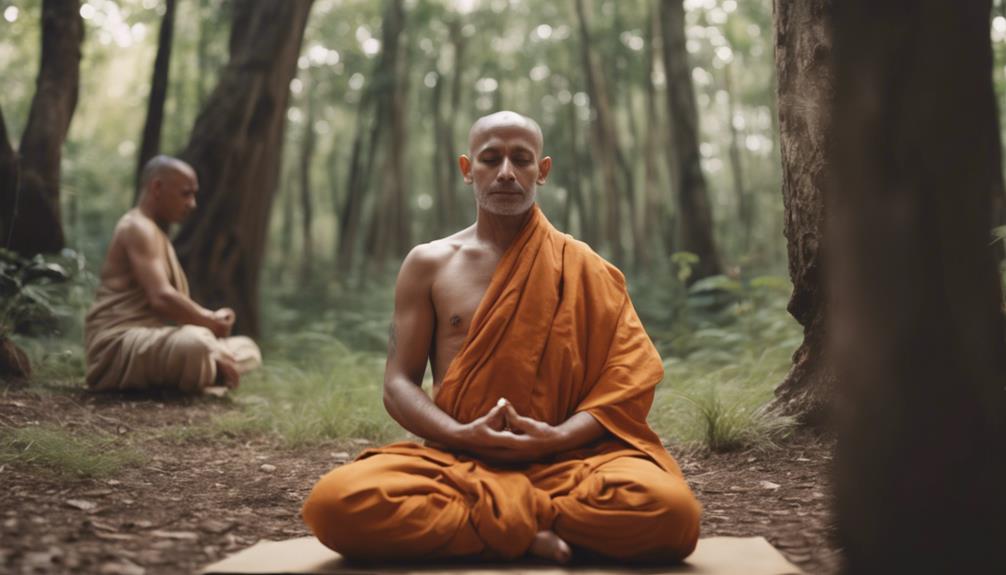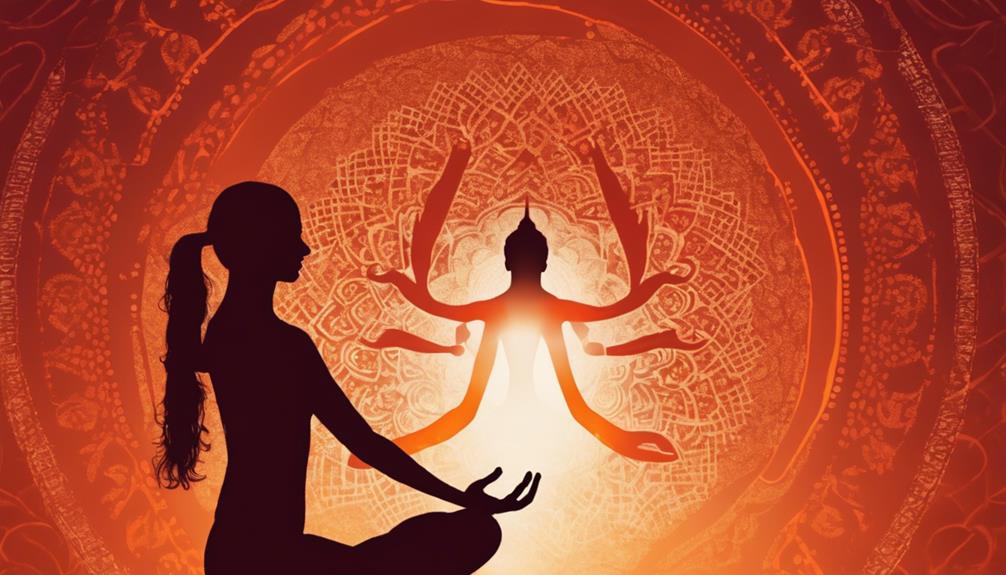Is Yoga a Hindu or Buddhist?
Yoga originates from ancient India, deeply rooted in Hindu philosophical traditions. It's a holistic discipline promoting mental, physical, and spiritual harmony. It's woven into the fabric of Hindu philosophy, facilitating self-realization and unity with the divine. However, Buddhism also incorporates yoga, using mindfulness and concentration practices to achieve mental clarity and enlightenment. Remember, though yoga grows from religious soil, its practices aren't exclusively religious. Its principles transcend these borders, offering benefits unrelated to religious beliefs, emphasizing global unity and inner peace. Just think, there's so much more to discover about yoga's fascinating evolution.
Key Takeaways
- Yoga originated in Northern India, deeply rooted in Hindu philosophy and practices, aiming at self-realization and divine unity.
- Yoga has been adopted and adapted by Buddhism, focusing on mental clarity, inner peace, and enlightenment.
- Both Hindu and Buddhist yoga emphasize mindfulness, physical and mental well-being, and self-realization, despite different practices and philosophies.
- Yoga is not inherently religious, but rather a holistic system promoting harmony, inner peace, and spiritual enlightenment.
- In modern times, yoga transcends religious boundaries and is globally practiced for its physical, mental, and spiritual benefits.
The Origins of Yoga

Diving into the rich tapestry of history, you'll find that yoga, as an ancient practice, traces its roots back to the Indus Valley Civilization in Northern India around 5,000 years ago. However, the true essence of yoga transcends its historical origin as it has evolved and adapted over millennia, integrating into various cultures and belief systems. This journey of yoga, from a spiritual discipline to a modern-day fitness regime, is indeed remarkable.
Yoga as exercise has become a global phenomenon, attracting millions due to its therapeutic benefits. It's not just a mere physical workout but a holistic system that harmonizes the mind, body, and spirit. Scientific studies support yoga's therapeutic benefits, highlighting its efficacy in enhancing physical health and emotional well-being.
Yet, it's important to understand that yoga's primary purpose wasn't fitness or therapy, but spiritual enlightenment. The physical postures, or asanas, that we associate with yoga today were initially a small part of a much larger philosophical system designed to facilitate meditation and spiritual growth. By appreciating the ancient origins of yoga, you can deepen your understanding of this practice, harnessing its full potential for both physical fitness and spiritual development.
Core Principles of Yoga
As you explore the core principles of yoga, you'll come to understand its ancient roots and how it has evolved in modern practice.
You'll examine yoga's foundational philosophies and concepts, and how they've been adapted over time.
This approach will provide a thorough perspective of yoga's diverse applications and universal appeal.
Yoga's Ancient Roots
In exploring the ancient roots of Yoga, you'll uncover not only its deep ties to Hindu and Buddhist traditions, but also the core principles that continue to guide its practice today. From its inception, Yoga has been a bridge between the physical and metaphysical, offering a path to spiritual enlightenment.
- Yoga's health benefits have been recognized for millennia, with practices designed to align mind, body, and spirit.
- The global influence of Yoga is undeniable, with millions embracing its principles worldwide.
- At its core, Yoga promotes self-awareness, mindfulness, and inner peace, principles that transcend religious boundaries.
While its roots are deeply embedded in Hinduism and Buddhism, Yoga's universal appeal lies in its adaptability and enduring wisdom.
Yoga in Modern Practice
Modern practice of Yoga retains its ancient core principles while adapting to contemporary needs and lifestyles. The commercialization of yoga has led to its widespread popularity, but it's not just about flexible bodies and stylish apparel. At its heart, yoga's health benefits are numerous, including stress reduction, enhanced flexibility, and improved cardio and circulatory health.
Yoga's essence, however, isn't lost in its current practice. Its principles of mindfulness, discipline, and unity of mind, body, and spirit still hold, even in the most modern yoga studio. The challenge is to sift through yoga's commercial appeal to find the authentic practice that yields not just physical but also mental and spiritual health. That's where yoga's true value lies in the modern world.
Yoga in Hindu Philosophy

You'll find that yoga's roots deeply embed themselves in Hindu philosophy, serving as a spiritual practice designed to help individuals realize their divine nature. This ancient tradition, intrinsically tied to Hindu rituals and various philosophical schools, encompasses more than physical postures.
To comprehend yoga's profound significance in Hinduism, consider the following:
- Yoga is an integral part of the six orthodox schools of Hindu philosophy. It's not merely a series of exercises, but a holistic system aiming at spiritual insight and tranquility.
- Hindu rituals often incorporate yogic practices, signifying a deep connection between the spiritual and physical domains. Yoga is a tool to reach a state of heightened consciousness, integral to these rituals.
- Yoga is closely associated with the Upanishads, ancient Hindu texts that emphasize self-realization. Yoga is a means to attain this realization, aligning the self with the divine.
The influence of yoga on Hindu philosophy is immense. It's a tool for self-discovery, a path to enlightenment, and a bridge between the physical and metaphysical. This innovative practice continues to evolve, demonstrating its enduring relevance across centuries.
We'll explore further in the next topic, 'Yoga's Role in Hinduism'.
Yoga's Role in Hinduism
Having established yoga's foundational role in Hindu philosophy, let's consider its practical applications and impacts within the domain of Hinduism. Fundamentally, yoga acts as a spiritual technology in Hinduism, assisting adherents in the exploration of consciousness and the attainment of self-realization.
Hinduism's yoga rituals aren't merely physical exercises; they're transformative practices designed to promote spiritual growth. These rituals, which combine postures, breath control, and meditation, serve as vehicles for self-discovery and enlightenment. They embody Yoga's spiritual symbolism, representing the union of individual consciousness with universal consciousness.
Moreover, yoga is integral to the concept of Dharma, the moral and ethical duties that individuals must fulfill to live a righteous life. Yoga provides a practical framework for the implementation of Dharma, helping individuals to develop discipline, focus, and self-awareness.
Innovation in yoga's practice and interpretation within Hinduism continues to evolve. Modern practitioners are encouraged to tailor their yoga practice to their individual needs and aspirations, providing a dynamic and adaptable spiritual tool.
Understanding Buddhism

Exploring Buddhism, it's important to understand that it's not just a religion, but a philosophy and spiritual practice deeply rooted in mindfulness and compassion. It's a path that encourages you to question, explore, and understand the nature of reality.
Buddhism is built around three fundamental concepts:
- The understanding of suffering (dukkha): Buddhism holds that life is characterized by suffering, but this suffering can be understood and overcome.
- Buddhist meditation techniques: These are tools for cultivating mindfulness, compassion, and wisdom. They provide a direct experience of the mind's potential and help you navigate life with greater ease and happiness.
- The Eightfold Path understanding: This is the path to awakening outlined by the Buddha. It's a practical guideline to ethical and mental development with the goal of freeing the individual from attachments and delusions.
These concepts aren't just philosophical principles, but practical tools for living a mindful and compassionate life. They invite you to be innovative, to think deeply, and to challenge your preconceptions. Buddhism isn't about blindly following dogma, but about understanding and experiencing life in a profoundly new way.
Yoga's Connection to Buddhism
Delving into the world of yoga reveals a substantial connection to Buddhism, particularly in the practice's emphasis on mindfulness, compassion, and the pursuit of enlightenment. Notably, Buddhist meditation techniques have had a significant impact on yoga. Zen, a school of Buddhism, has particularly reshaped yoga practices with its stress on meditation and mindfulness.
To give you a better understanding, let's consider a comparison table:
| Aspect | Buddhism and Yoga |
|---|---|
| Mindfulness | Both advocate for a heightened awareness of the present moment. |
| Compassion | They promote empathy and compassion towards self and others. |
| Enlightenment | The ultimate goal is to attain a state of spiritual enlightenment. |
Furthermore, the Zen influence on yoga cannot be overlooked. Zen emphasizes the experience of meditation over theoretical knowledge. This principle is evident in yoga practices, where the focus is on experiencing poses and breathing exercises, rather than merely understanding them.
Differences in Yoga Practices

Exploring the differences in yoga practices is crucial to delve into the origins of these traditions.
How do Hindu and Buddhist interpretations of yoga differ?
Origins of Yoga Practices
While you may associate yoga primarily with fitness in the western context, it's crucial to explore its roots to understand its origins and various practices in Hinduism and Buddhism.
- First, consider yoga's health benefits. Originating thousands of years ago, yoga was developed as a means to attain spiritual enlightenment, with physical health benefits a happy byproduct.
- Second, observe the application of yoga in sports, where it's used for injury prevention and to improve flexibility, strength, and mental focus.
- Third, it's important to note that yoga's practices evolved differently in Hinduism and Buddhism, each incorporating unique elements and philosophies.
Understanding yoga's past allows for innovative applications of its practices in today's world.
Hindu Yoga Traditions
In Hindu tradition, you'll find a multitude of yoga practices, each deeply embedded in the religion's philosophical framework and spiritual objectives. Hindu rituals influence these methods greatly, shaping Yoga's ethical teachings and making them unique.
Below is a table detailing two key differences in Hindu Yoga traditions:
| Aspect | Description |
|---|---|
| Philosophical Focus | Rooted in Hindu philosophy, each yoga practices aim at self-realization and unity with the divine, reflecting the spiritual objectives of Hinduism. |
| Ritual Influence | Hindu rituals often shape yoga practices, integrating elements like mantra chanting, meditation, and ethical teachings into the yoga routine. |
These distinctions reveal how intertwined yoga is with Hinduism, yet highlight its adaptability, appealing to audiences seeking innovative ways to approach spirituality and wellness. Next, we'll explore Buddhist interpretations of yoga, revealing the fascinating cross-cultural exchange in this timeless practice.
Buddhist Yoga Interpretations
Turning our attention to Buddhism, we find that this tradition also incorporates yoga practices, yet does so with a unique spin that reflects its distinct spiritual aims and philosophical underpinnings. Buddhist yoga interpretations, deeply rooted in Buddhist philosophy, focus on achieving mental clarity and inner peace.
- Mindfulness (Vipassana): This meditation technique encourages non-judgmental observation of the present moment.
- Loving-kindness (Metta): Here, you're cultivating unconditional love and compassion towards all living beings.
- Concentration (Samatha): This technique is about focusing your mind on a single object to achieve tranquility.
These practices aren't just exercises; they're tools for enlightenment. So, while you're exploring innovative paths, remember that yoga isn't monolithic—its interpretations are as varied as the philosophies that inspire them.
Similarities in Yoga Teachings

You'll find numerous similarities in yoga teachings across both Hindu and Buddhist traditions, reflecting a shared historical and philosophical lineage. This commonality isn't surprising, as both religions originate from ancient India, and their practices have evolved over centuries, influencing each other.
One key similarity is the emphasis on developing mindfulness and focus, which are integral components of both Hindu and Buddhist yoga. These teachings aren't just about physical flexibility or strength; they're also about mental resilience and spiritual growth.
Another shared emphasis is the role of yoga in promoting health. Both traditions recognize Yoga's potential to improve physical and mental well-being. This understanding of Yoga and health has played a significant role in Yoga's global influence, making it a popular practice worldwide.
Moreover, both traditions use yoga as a tool for self-realization and spiritual enlightenment. They view yoga as a path towards understanding the true nature of the self and reality.
Modern Interpretations of Yoga
While these ancient teachings continue to influence yoga practices, modern interpretations have greatly expanded the concept and application of Yoga. You see, alongside the traditional spiritual and philosophical elements, yoga's commercialization has led to a broad spectrum of styles and purposes.
- Yoga has been repackaged as a physical exercise regimen, focusing on flexibility, strength, and balance. It's been stripped of its religious trappings and sold as a secular, health-oriented practice.
- Yoga's health benefits have been widely promoted, from stress reduction and improved mental clarity to enhanced physical fitness and chronic disease management.
- Yoga has also become a platform for self-expression and identity construction, with practitioners creating unique styles and narratives around their practice.
These modern interpretations not only have diversified yoga but also democratized it, making it accessible to a broader audience. It's a tribute to yoga's enduring appeal and adaptability, its ability to resonate with different cultures and contexts. But as with all changes, these interpretations raise questions about authenticity, appropriation, and the line between innovation and commodification.
As you navigate this landscape, remember, yoga's essence lies in its capacity for transformation, self-discovery, and well-being.
Yoga: A Universal Practice

Over time, yoga has evolved into a universal practice, transcending religious boundaries and integrating into diverse cultures worldwide. It's no longer confined to its Indian origins or its perceived spiritual roots; rather, it stands as a demonstration of global unity and acceptance. The diversity of yoga's forms, from hatha to ashtanga, vinyasa to yin, signifies its worldwide appeal and adaptability.
Yoga's benefits are manifold, encompassing physical, mental, and emotional well-being. From enhancing flexibility and strength to promoting mindfulness and stress reduction, yoga is a holistic approach to wellness that resonates across cultures. It's not only the physical postures that are universal; the principles of self-discipline, compassion, and inner peace are also universally relevant, regardless of one's religious or cultural background.
The universality of yoga is a demonstration of its inherent adaptability and resilience. It's a dynamic practice that continues to evolve and innovate, meeting the needs of a diverse and global community. Its universality isn't a sign of dilution or appropriation, but rather, a celebration of yoga's diversity and inclusivity. This universality, in turn, enriches yoga's benefits, making it a truly global wellness practice.
Disentangling Yoga's Religious Roots
To unravel yoga's religious roots, it's important to explore its origins and historical context. Yoga's genesis lies in the ancient Indian subcontinent, and it's intricately linked with Hinduism. However, as you investigate further, you'll comprehend that it's not exclusively tied to any one faith.
- Yoga's Global Spread: Yoga has spread globally, far beyond its birthplace, embraced by diverse cultures and religions. This universal acceptance has led to a decoupling of yoga from its religious connotations, making it more of a global phenomenon.
- Yoga's Therapeutic Benefits: Yoga's therapeutic benefits have been recognized worldwide, contributing to its popularity. Its mental and physical benefits, such as stress reduction and improved flexibility, have made it a sought-after practice, irrespective of religious beliefs.
- Yoga and Religion: Despite its Hindu origins, yoga isn't inherently religious. It's an amalgamation of physical exercises, meditation, and ethical principles. As a result, it's been adopted by other religions, including Buddhism, without any conflict.



